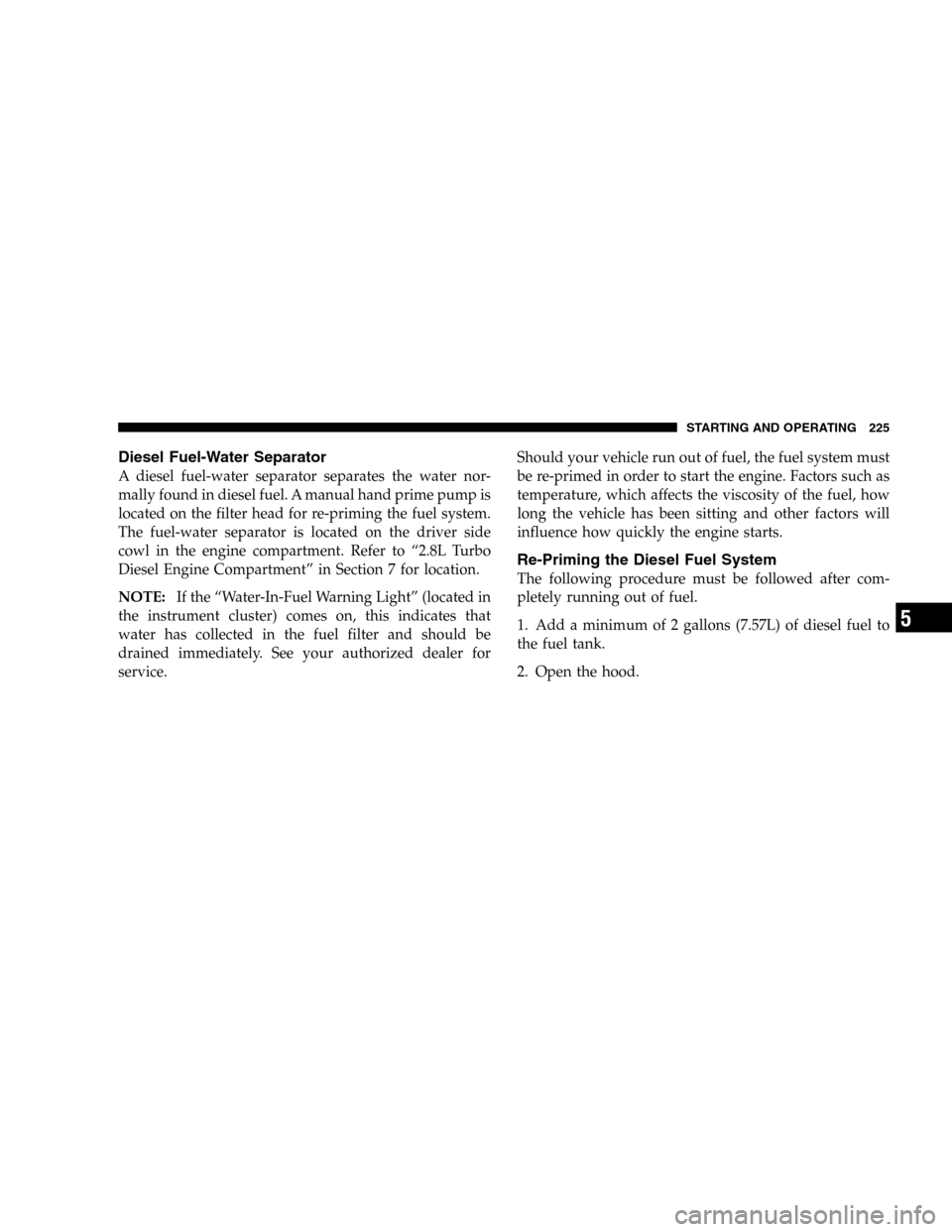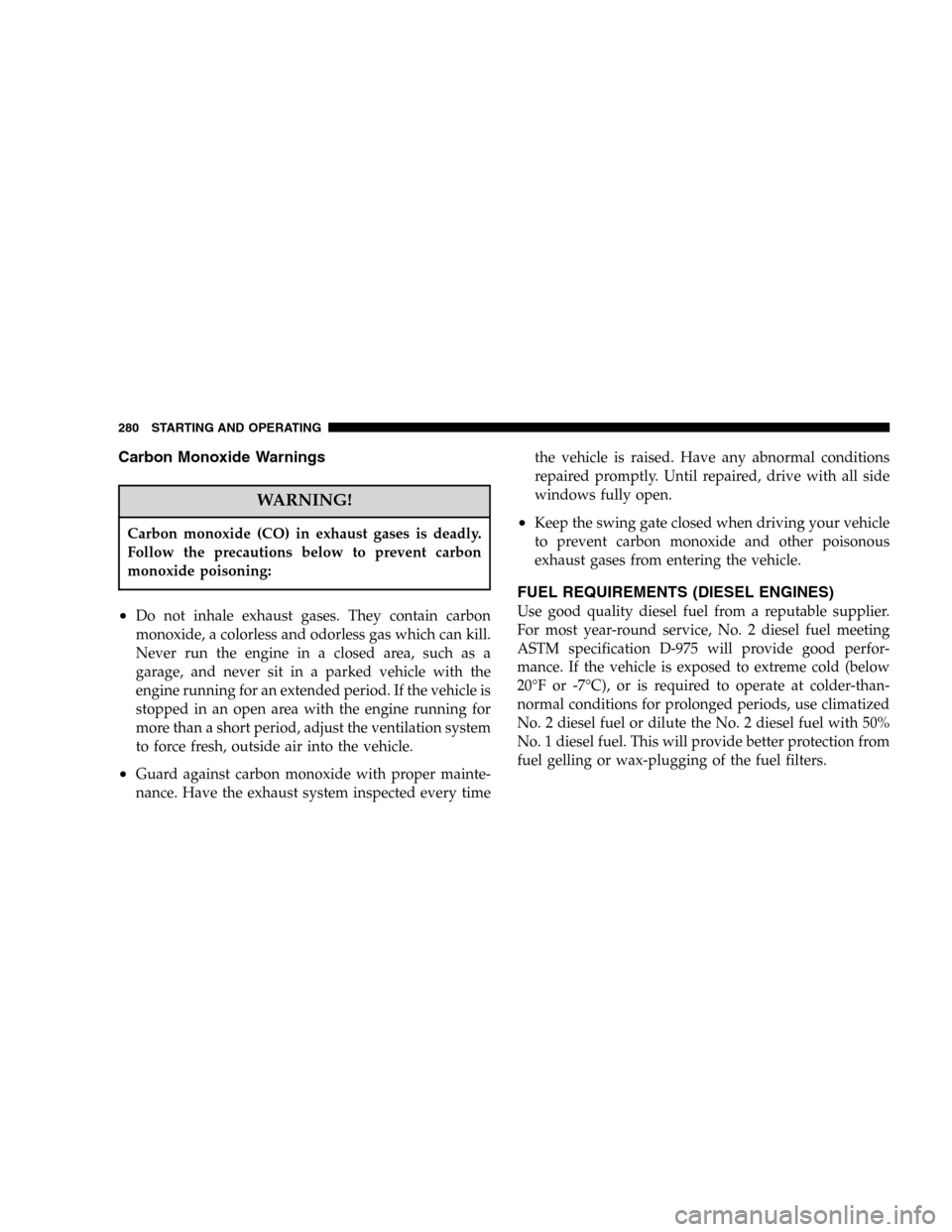Page 175 of 424

24. O/D (Overdrive) Off Indicator Light
This light will illuminate when the O/D OFF
button has been selected. The O/D OFF button is
located on the gear shift lever.
25. Seat Belt Indicator Light
When the ignition switch is first turned ON, this
light will turn on for 5 to 8 seconds as a bulb check.
During the bulb check, if the driver’s seat belt is
unbuckled, a chime will sound. After the bulb check or
when driving, if the driver seat belt remains unbuckled,
the Seat Belt Warning Light will flash or remain on
continuously. Refer to�Enhanced Driver Seat Belt Re-
minder System (BeltAlert)�in the Occupant Restraints
section for more information.
26. Light Bar Indicator Light — If Equipped
This light indicates when the light bar lamps
are on.27. Water In Fuel Warning Light — If Equipped
This light indicates water has collected in the
fuel filter and should be drained immediately.
See your authorized dealer for service. (See
page 220 for more information.)
28. Low Coolant Warning Light — If Equipped
This light comes on if the coolant level is low.
This light will come on for 3 seconds as a bulb
check when the ignition switch is first turned
to the ON position.
29. Electronic Throttle Control (ETC) Warning Light —
If Equipped
This light informs you of a problem with the
Electronic Throttle Control system. If a problem
is detected the light will come on while the
engine is running. Cycle the ignition key when
the vehicle has completely stopped and the gear selector
is placed in the P (Park) position. The light should turn
UNDERSTANDING YOUR INSTRUMENT PANEL 175
4
Page 225 of 424

Diesel Fuel-Water Separator
A diesel fuel-water separator separates the water nor-
mally found in diesel fuel. A manual hand prime pump is
located on the filter head for re-priming the fuel system.
The fuel-water separator is located on the driver side
cowl in the engine compartment. Refer to “2.8L Turbo
Diesel Engine Compartment” in Section 7 for location.
NOTE:If the “Water-In-Fuel Warning Light” (located in
the instrument cluster) comes on, this indicates that
water has collected in the fuel filter and should be
drained immediately. See your authorized dealer for
service.Should your vehicle run out of fuel, the fuel system must
be re-primed in order to start the engine. Factors such as
temperature, which affects the viscosity of the fuel, how
long the vehicle has been sitting and other factors will
influence how quickly the engine starts.
Re-Priming the Diesel Fuel System
The following procedure must be followed after com-
pletely running out of fuel.
1. Add a minimum of 2 gallons (7.57L) of diesel fuel to
the fuel tank.
2. Open the hood.
STARTING AND OPERATING 225
5
Page 226 of 424
3. Depress the fuel-water separator knob 20 consecutive
times.
4. Turn the ignition to START and crank the engine a
maximum of 10 seconds. If the engine does not start,
repeat Step 3.NOTE:The engine will typically start within 10 sec-
onds; the engine will idle then stall, purging air from the
fuel lines and filter.
5. Depress the fuel-water separator knob 20 consecutive
times.
6. Turn the ignition to START and crank the engine a
maximum of 10 seconds. The engine should start and
remain running.
NOTE:If the engine does not start, repeat the cycle as
many times as necessary.
ENGINE BLOCK HEATER — IF EQUIPPED
The engine block heater warms engine coolant and
permits quicker starts in cold weather. Connect the cord
to a standard 110-115 volt AC electrical outlet with a
grounded, three wire extension cord. The engine block
heater cord is found under the hood clipped to the heater
line on the left side of the engine (3.7L only).Hand Prime Pump
226 STARTING AND OPERATING
Page 280 of 424

Carbon Monoxide Warnings
WARNING!
Carbon monoxide (CO) in exhaust gases is deadly.
Follow the precautions below to prevent carbon
monoxide poisoning:
•Do not inhale exhaust gases. They contain carbon
monoxide, a colorless and odorless gas which can kill.
Never run the engine in a closed area, such as a
garage, and never sit in a parked vehicle with the
engine running for an extended period. If the vehicle is
stopped in an open area with the engine running for
more than a short period, adjust the ventilation system
to force fresh, outside air into the vehicle.
•Guard against carbon monoxide with proper mainte-
nance. Have the exhaust system inspected every timethe vehicle is raised. Have any abnormal conditions
repaired promptly. Until repaired, drive with all side
windows fully open.
•Keep the swing gate closed when driving your vehicle
to prevent carbon monoxide and other poisonous
exhaust gases from entering the vehicle.
FUEL REQUIREMENTS (DIESEL ENGINES)
Use good quality diesel fuel from a reputable supplier.
For most year-round service, No. 2 diesel fuel meeting
ASTM specification D-975 will provide good perfor-
mance. If the vehicle is exposed to extreme cold (below
20°F or -7°C), or is required to operate at colder-than-
normal conditions for prolonged periods, use climatized
No. 2 diesel fuel or dilute the No. 2 diesel fuel with 50%
No. 1 diesel fuel. This will provide better protection from
fuel gelling or wax-plugging of the fuel filters.
280 STARTING AND OPERATING
Page 303 of 424
MAINTAINING YOUR VEHICLE
CONTENTS
�2.4L Engine...........................306
�3.7L Engine...........................307
�2.8L Turbo Diesel Engine.................308
�Onboard Diagnostic System — OBD II........309
▫Loose Fuel Filler Cap Message............309
�Emissions Inspection And Maintenance
Programs............................310
�Replacement Parts......................311
�Dealer Service.........................312�Maintenance Procedures..................312
▫Engine Oil..........................312
▫Drive Belts — Check Condition And Tension . . 316
▫Spark Plugs.........................317
▫Catalytic Converter....................317
▫Engine Timing Belt — 2.4L Engine.........319
▫Ignition Wiring System — 2.4L Engine......319
▫Crankcase Emission Control System........319
▫Air Cleaner Filter.....................319
7
Page 356 of 424
FLUID CAPACITIES
U.S. Metric
Fuel (Approximate)20.5 Gallons 78 Liters
Engine Oil with Filter
2.4/3.7 Liter Engines (SAE 5W-30, API Certified Engine Oil) 5 Qts 4.7 Liters
2.8 Liter Diesel Engine (SAE 0W-40 Mobil 1�Synthetic, API
Certified Engine Oil)6.4 Qts 6.1 Liters
Cooling System *
2.4 Liter Engine (Mopar�Antifreeze/Coolant 5 Year/100,000
Mile Formula)10 Qts 9.5 Liters
3.7 Liter Engine (Mopar�Antifreeze/Coolant 5 Year/100,000
Mile Formula)14 Qts 13.2 Liters
2.8 Liter Diesel Engine (Mopar�Antifreeze/Coolant 5 Year/
100,000 Mile Formula)11.8 Qts 12.5 Liters
* Includes heater and coolant recovery bottle filled to MAX level.
356 MAINTAINING YOUR VEHICLE
Page 357 of 424

RECOMMENDED FLUIDS, LUBRICANTS AND GENUINE PARTS
Engine
Component Fluid, Lubricant, or Genuine Part
Engine Coolant Mopar�Antifreeze/Coolant 5 Year/100,000 Mile Formula HOAT (Hybrid Or-
ganic Additive Technology)
Engine Oil (2.4L and 3.7L Engines) Use API Certified SAE 5W-30 Engine Oil, meeting the requirements of
DaimlerChrysler Material Standard MS-6395.
Engine Oil (2.8L Diesel Engines) Use API Certified SAE 0W-40 Mobil 1�Synthetic Engine Oil that meets API
Categories SL/CF, and the requirements of DaimlerChrysler Material Stan-
dard MS-10725. If SAE 0W-40 is not available, SAE 5W-40 Mobil 1�Synthetic
Engine Oil is acceptable.
Oil Filter (2.4L Engine) Mopar�Oil Filter (P/N 4105409 or 4105409AB)
Oil Filter (3.7L Engine) Mopar�Oil Filter (P/N 4781452AA or 4781452BB)
Oil Filter (2.8L Diesel Engine) Mopar�Oil Filter (P/N 05072720AA)
Spark Plugs Refer to the Vehicle Emission Control Information label in the engine com-
partment.
Fuel Selection (Gasoline Engines
Only)87 Octane (89 Octane should be used for trailer towing purposes - 3.7L
Only).
MAINTAINING YOUR VEHICLE 357
7
Page 362 of 424

At Each Stop for Fuel
•Check the engine oil level about 5 minutes after a fully
warmed engine is shut off. Checking the oil level while
the vehicle is on level ground will improve the accu-
racy of the oil level reading. Add oil only when the
level is at or below the ADD or MIN mark.
•Check the windshield washer solvent, add as required.
Once a Month
•Check the tire pressure and look for unusual wear or
damage.
•Inspect the battery, and clean and tighten the terminals
as required.
•Check the fluid levels of the engine coolant/anti-
freeze reservoir, brake master cylinder, and transmis-
sion, and add as needed.
•Check all lights and all other electrical items for correct
operation.
At Each Oil Change
•Change the engine oil filter.
•Inspect the exhaust system.
•Inspect brake hoses.
•Check the engine coolant/anti-freeze level, hoses, and
clamps.
•Inspect manual transmission fluid level, and for leaks
(if equipped).
•After completion of off-road operation, the underside
of the vehicle should be thoroughly inspected. Exam-
ine threaded fasteners for looseness.
362 MAINTENANCE SCHEDULES
8
M
A
I
N
T
E
N
A
N
C
E
S
C
H
E
D
U
L
E
S